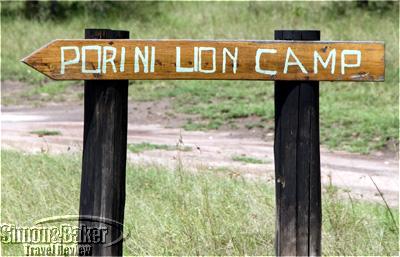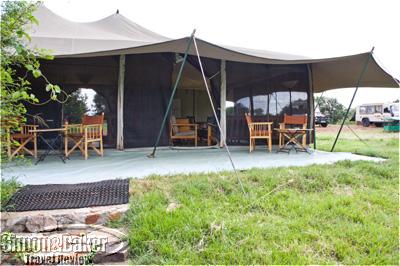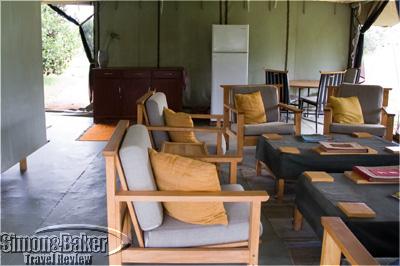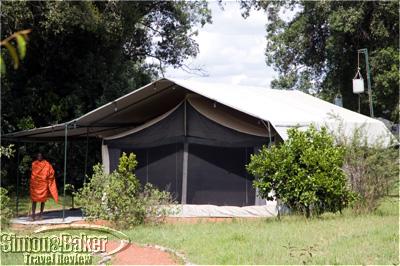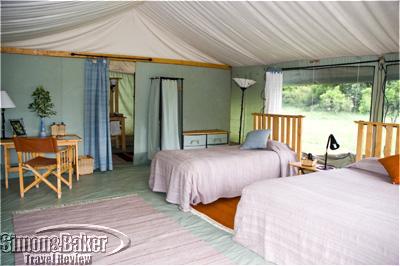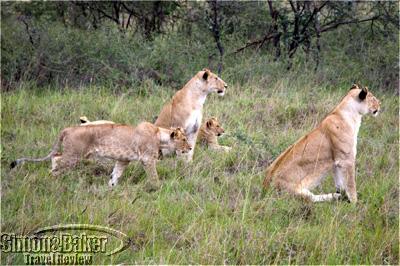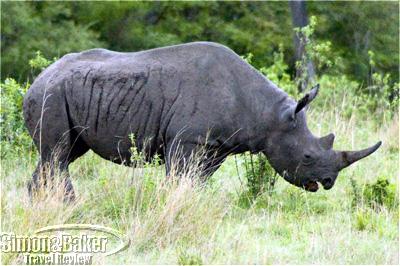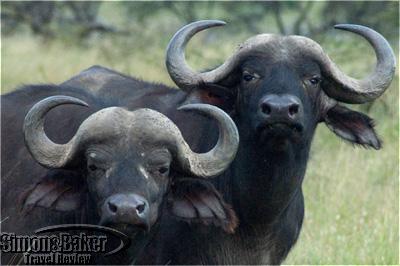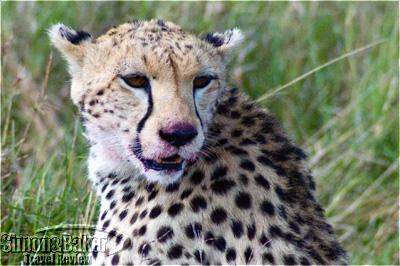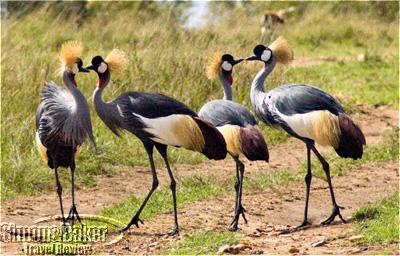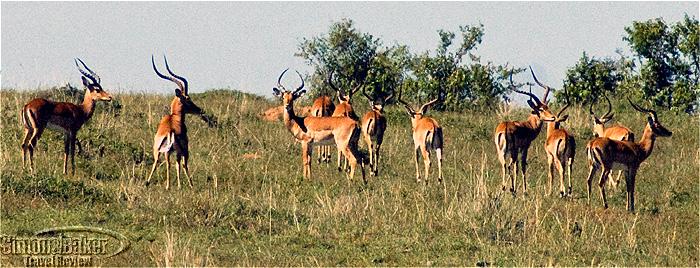
This superb safari experience was further enhanced by the exceptional quality of the camp. Strung along the bank of the Ntiakatiak River, a seasonal river with some permanent hippo pools, the camp featured oversized tents of the latest design. All outer walls were floor to ceiling zippered panels that could be completely open from inside the tent to reveal mesh panels for outstanding light and air circulation. The interior color scheme was ecru and ice blue with bold tangerine accents; the clean-lined pale wood furniture was reminiscent of modern Italian design. A deep ground-level veranda ran along the entire length of the tent. My tent overlooked a rolling hill where large herds of gazelles came to graze. The result was a serene environment perfectly suited to fully appreciate the grandeur of the African bush.
Porini Lion Camp and its host game reserve, the Olare Orok Conservancy, were a cooperative venture between Gamewatchers Safaris (Porini’s parent company) and the local Masai landowners. The majority of the camp staff were local tribesmen, including my guide, John Totona Giololo, and spotter, George Kiama Morunya. Both were justifiably proud of the rich fauna and breathtaking vistas of their corner of the Mara and clearly committed to ensure that I experience it. Every member of the staff I came in contact with was equally well trained, friendly and attentive to my smallest needs and wishes. With its eye-popping game viewing, superb accommodations, strict environmentally-friendly practices and excellent staff, Porini Lion Camp was one of the best bush camps I have ever visited!
Communications There was no Internet connection at the camp. Bluetooth and mobile phone service was unreliable. When available, it required a GSM 900/1800 compatible international cellular phone.
General Manager Alphonse Omondi
Handicapped Access Mobility impaired guests could be accommodated by prior arrangement on a case-by-case basis.
Length Of Stay Three nights
Location In the Olare Orok Conservancy on the northern border of the Masai Mara National Reserve in southwest Kenya. The nearest airstrip, Ol Kiombo, was eight miles (13 kilometers) away. Olare Orok Conservancy was 155 miles (250 kilometers) from Nairobi by road, a journey that was estimated to take four to five hours.
Owned-Managed Gamewatchers Safaris (Jake Grieves-Cook, Managing Director)
Power All electricity was solar generated. The tents had electric lighting, but not sufficient power to charge batteries. Batteries for cameras, telephones and laptops could be charged from a small solar-powered generator in the camp manager’s office tent.
Size The 12 acre (five hectare) camp consisted of 10 guest tents capable of accommodating up to 24 guests. It employed a staff of 33, including five guides and three spotters.
Year Open-Renovated The camp opened in 2006
Room My 500 square foot (47.5 square meter) tent, Tembo (Swahili for elephant), sat on level, sandy ground covered with light blue weatherproof floor matting. A matching blue canvas partition separated the sleeping room from the bathroom that occupied the far quarter of the tent. At the front, an awning-covered veranda ran the length of the tent. It was furnished with two directors chairs and a small occasional table. The entrance was a large zippered panel in the center of the tent. Inside, furniture was of contemporary beech wood and ice blue canvas, with tangerine accent pillows and scattered rugs. Two beds (one queen-size and one double) with high, spindled wooden headboards, each with a bedside table and reading lamp occupied the side opposite the entrance door. The bathroom partition featured a center doorway closed by blue tweed woven cloth panel. On one side of the opening a director’s armchair sat in front of a writing desk holding a desk lamp and small mirror, to double as a dressing table. On the other side of the door, a tall canvas-sided hanging closet sat next to a four-drawer wooden and canvas bureau and a wrought iron floor lamp. Indoor lighting was provided through solar electricity.
During my visit, I sighted: lion, elephant, buffalo, leopard, rhinoceros, cheetah, caracal, spotted hyena, honey badger, bat-eared fox, slender mongoose, warthog, Nile crocodile, hippopotamus, leopard tortoise, Masai giraffe, eland, oribi, Kirk’s dik dik, Grant’s gazelle, Thompson’s gazelle, topi, wildebeest, hartebeest, impala, Burchell’s zebra, vervet monkey. Birds included: Masai ostrich, secretary bird, white-browed coucal, white-bellied bustard, long-crested eagle, rufus-napped lark, bateleur eagle, black-headed heron, white-headed vulture, malachite kingfisher, Ruppell’s long-tailed starling, grey heron, tawny eagle, woolly-necked stork, spur-winged plover, northern wheatear, red-necked spurfowl, steppe eagle, pigmy falcon, northern white-crowned shrike, auger buzzard
Porini Lion Camp was run and maintained according to strict responsible tourism guidelines regarding conservation of the environment (including use of natural resources and solid waste and sewerage disposal) as well as providing development opportunities for the local community. At the time of my visit 90 percent of the staff was from the local Masai community.
Shortly after my visit Porini Safari Camps and parent company Gamewatchers Safaris were honored with the Responsible Tourism Award for “Best for Conservation of Endangered Species outside Protected Area” at the World Travel Market in London. The award, sponsored by Virgin Holidays, recognized Porini/Gamewatchers “for demonstrating that a high revenue, low impact tourism development approach can benefit the local Masai through developing conservancies and tourism in partnership with safari companies to create employment and community income and to conserve their land for wildlife.”
Date Of Last Visit November 2008
Reviewers Article and photographs by Josette King
Service My tent was serviced twice daily, a morning cleaning and an evening turn down service . Every member of the staff I encountered was attentive, friendly, helpful and well trained.
Would You Stay There Again? Yes
Contact Information
- Porini Safari Camps
- Village Market Complex
- P.O. Box 388-00621
- Nairobi, Kenya
- + 254 (20) 7123129
- + 254 (20) 7121851
- + 254 (20) 7122504
- + 254 (20) 7120864
